TOYOTA PRIUS PLUG-IN 2015 Owners Manual
Manufacturer: TOYOTA, Model Year: 2015, Model line: PRIUS PLUG-IN, Model: TOYOTA PRIUS PLUG-IN 2015Pages: 728, PDF Size: 20.85 MB
Page 371 of 728
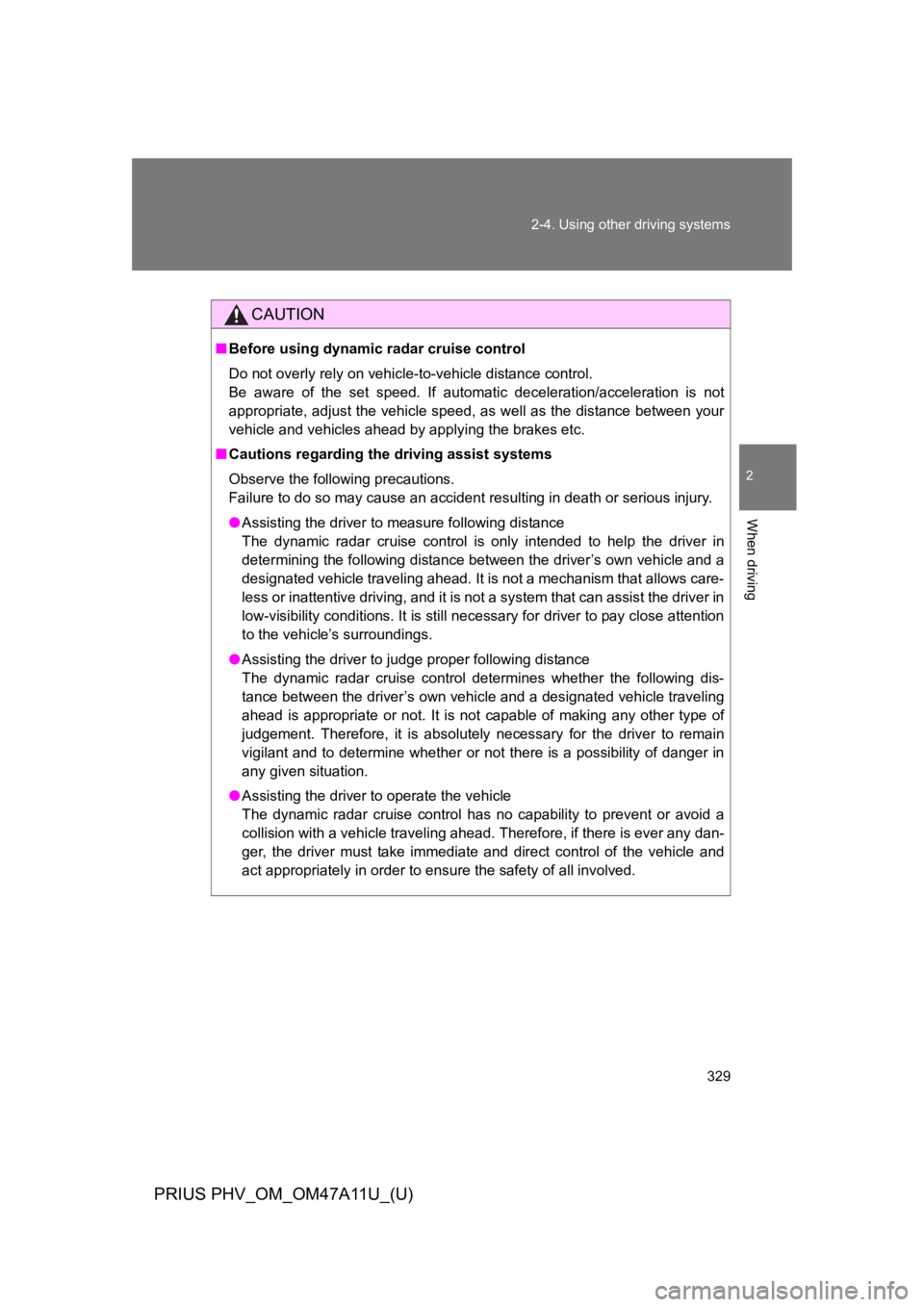
329
2-4. Using other driving systems
PRIUS PHV_OM_OM47A11U_(U)
2
When driving
CAUTION
■Before using dynamic radar cruise control
Do not overly rely on vehicle-to-vehicle distance control.
Be aware of the set speed. If automatic deceleration/acceleration is not
appropriate, adjust the vehicle speed, as well as the distance between your
vehicle and vehicles ahead by applying the brakes etc.
■Cautions regarding the driving assist systems
Observe the following precautions.
Failure to do so may cause an accident resulting in death or serious injury.
●Assisting the driver to measure following distance
The dynamic radar cruise control is only intended to help the driver in
determining the following distance between the driver’s own vehicle and a
designated vehicle traveling ahead. It is not a mechanism that allows care-
less or inattentive driving, and it is not a system that can assist the driver in
low-visibility conditions. It is still necessary for driver to pay close attention
to the vehicle’s surroundings.
●Assisting the driver to judge proper following distance
The dynamic radar cruise control determines whether the following dis-
tance between the driver’s own vehicle and a designated vehicle traveling
ahead is appropriate or not. It is not capable of making any other type of
judgement. Therefore, it is absolutely necessary for the driver to remain
vigilant and to determine whether or not there is a possibility of danger in
any given situation.
●Assisting the driver to operate the vehicle
The dynamic radar cruise control has no capability to prevent or avoid a
collision with a vehicle traveling ahead. Therefore, if there is ever any dan-
ger, the driver must take immediate and direct control of the vehicle and
act appropriately in order to ensure the safety of all involved.
Page 372 of 728

330
2-4. Using other driving systems
PRIUS PHV_OM_OM47A11U_(U)
CAUTION
■To a v o i d i n a d v e r t e n t c ruise control activation
Switch the cruise control off using the “ON-OFF” button when not in use.
■Situations unsuitable for dynamic radar cruise control
Do not use dynamic radar cruise control in any of the following situations.
Doing so may result in inappropriate speed control and could cause an acci-
dent resulting in death or serious injury.
●Except on highways or expressways
●In heavy traffic
●On roads with sharp bends
●On winding roads
●On slippery roads, such as those covered with rain, ice or snow
●On steep downhills, or where there are sudden changes between sharp up
and down gradients
Ve h i c l e s p e e d m a y e x c e e d t h e s e t s p e e d w h e n d r i v i n g d o w n a s t e e p h i l l .
●At entrances to expressways
●When weather conditions are bad enough that they may prevent the sen-
sors from functioning correctly (fog, snow, sandstorm, heavy rain, etc.)
●When an approach warning buzzer is heard often
●During emergency towing
Page 373 of 728
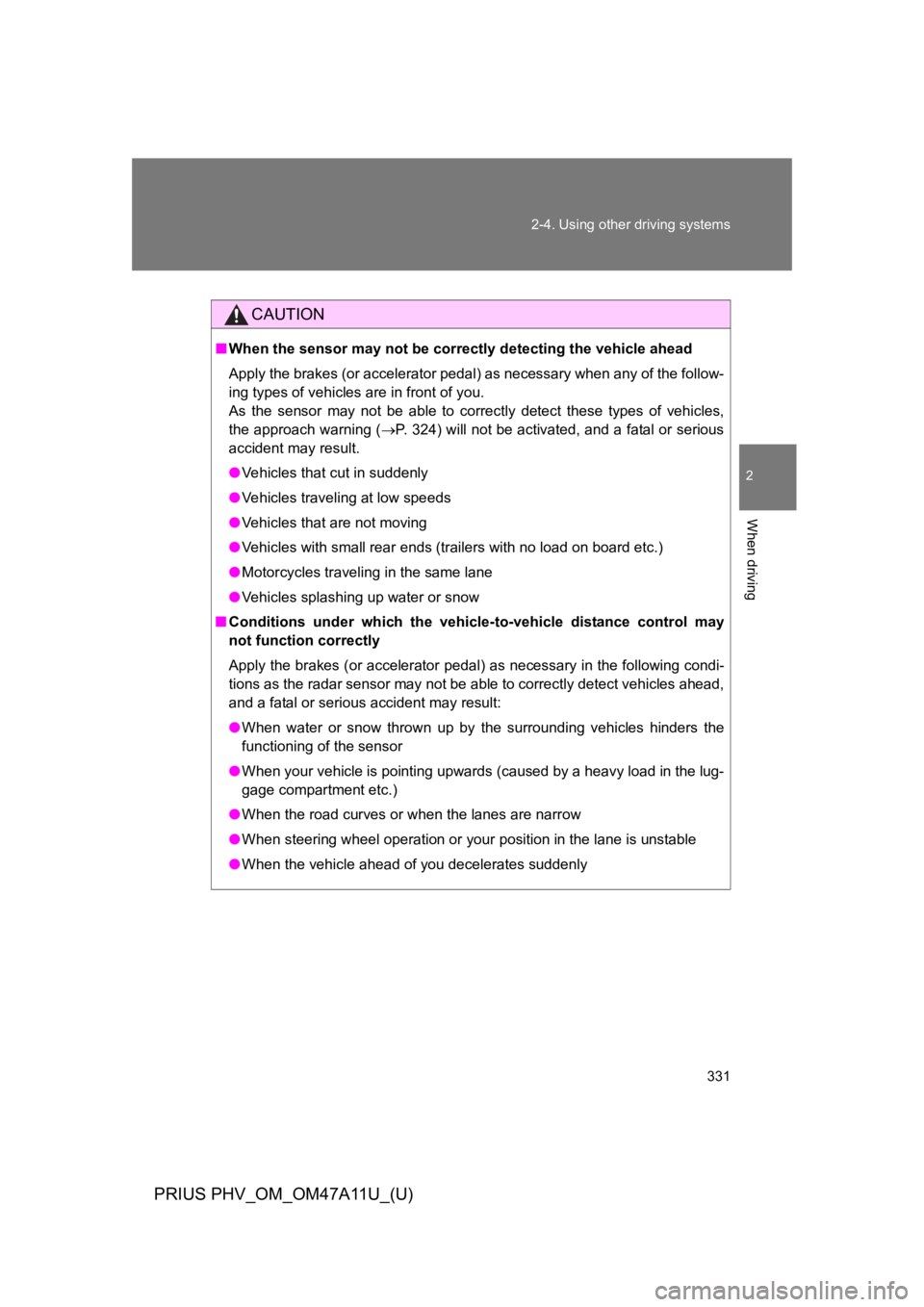
331
2-4. Using other driving systems
PRIUS PHV_OM_OM47A11U_(U)
2
When driving
CAUTION
■When the sensor may not be correctly detecting the vehicle ahead
Apply the brakes (or accelerator pedal) as necessary when any of the follow-
ing types of vehicles are in front of you.
As the sensor may not be able to correctly detect these types of vehicles,
the approach warning (�oP. 3 2 4 ) w i l l n o t b e a c t i v a t e d , a n d a f a t a l o r s e r i o u s
accident may result.
●Ve h i c l e s t h a t c u t i n s u d d e n l y
●Ve h i c l e s t r a v e l i n g a t l o w s p e e d s
●Ve h i c l e s t h a t a r e n o t m o v i n g
●Ve h i c l e s w i t h s m a l l r e a r e n d s ( t r a i l e r s w i t h n o l o a d o n b o a r d e t c . )
●Motorcycles traveling in the same lane
●Ve h i c l e s s p l a s h i n g u p w a t e r o r s n o w
■Conditions under which the vehicle-to-vehicle distance control may
not function correctly
Apply the brakes (or accelerator pedal) as necessary in the following condi-
tions as the radar sensor may not be able to correctly detect vehicles ahead,
and a fatal or serious accident may result:
●When water or snow thrown up by the surrounding vehicles hinders the
functioning of the sensor
●When your vehicle is pointing upwards (caused by a heavy load in the lug-
gage compartment etc.)
●When the road curves or when the lanes are narrow
●When steering wheel operation or your position in the lane is unstable
●When the vehicle ahead of you decelerates suddenly
Page 374 of 728

332
2-4. Using other driving systems
PRIUS PHV_OM_OM47A11U_(U)
CAUTION
■Handling the radar sensor
Observe the following to ensure the cruise control system can function effec-
tively.
Otherwise, the system may not function correctly and could result in an acci-
dent.
●Keep the sensor and grille cover clean at all times.
Clean the sensor and grille cover with a soft cloth so you do not mark or
damage them.
●Do not subject the sensor or surrounding area to a strong impact.
If the sensor moves even slightly off position, the system may become
inaccurate or malfunction. If the sensor or surrounding area is subject to a
strong impact, always have the area inspected and adjusted by your Toy-
ota dealer.
●Do not disassemble the sensor.
●Do not attach accessories or stickers to the sensor, grille cover or sur-
rounding area.
●Do not modify or paint the sensor and grille cover.
●Do not replace them with non-genuine parts.
Page 375 of 728
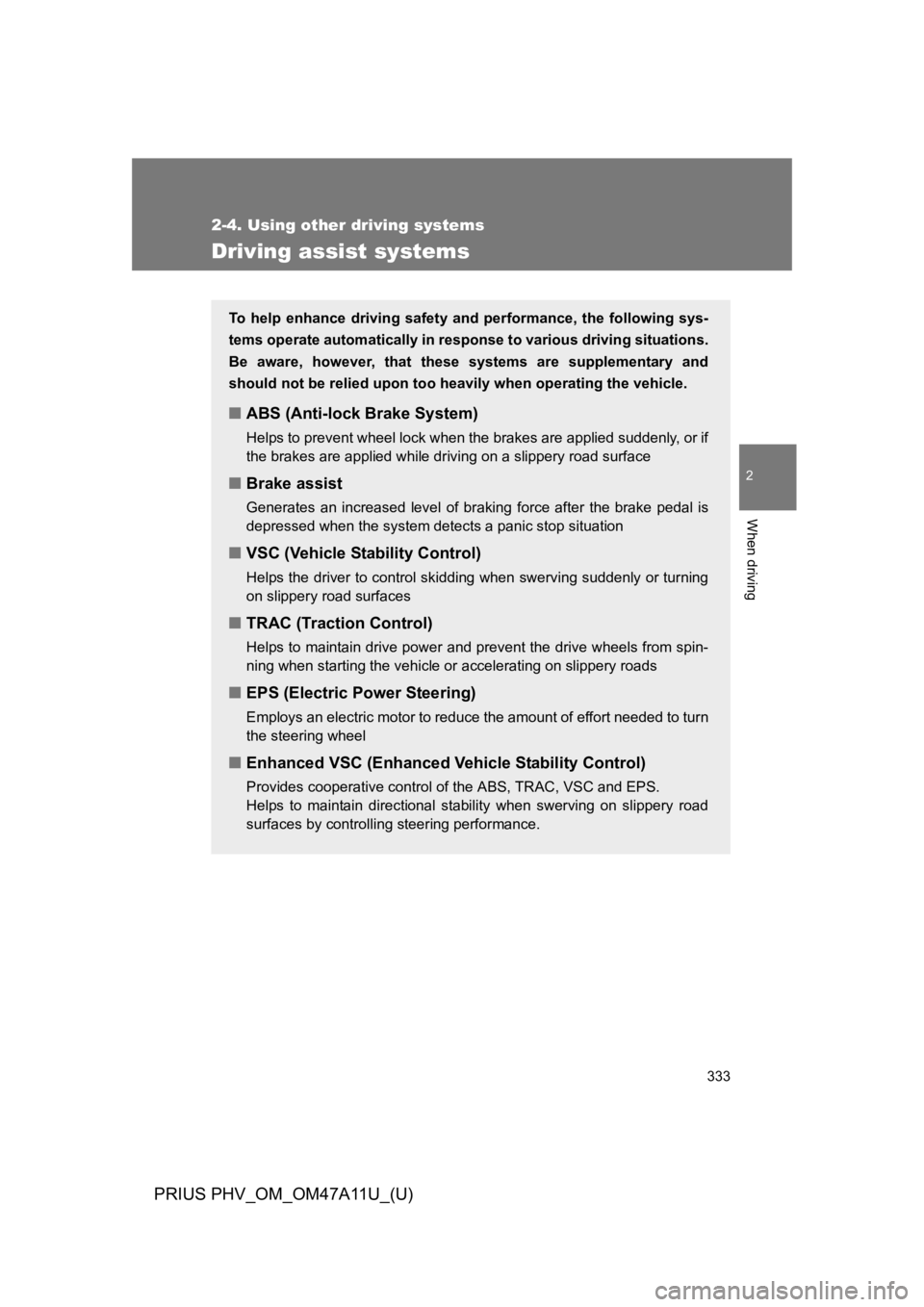
333
2-4. Using other driving systems
PRIUS PHV_OM_OM47A11U_(U)
2
When driving
Driving assist systems
To h e l p e n h a n c e d r i v i n g s a f e t y and performance, the following sys-
tems operate automatically in response to various driving situations.
Be aware, however, that these systems are supplementary and
should not be relied upon too heavily when operating the vehicle.
■ABS (Anti-lock Brake System)
Helps to prevent wheel lock when the brakes are applied suddenly, or if
the brakes are applied while driving on a slippery road surface
■Brake assist
Generates an increased level of braking force after the brake pedal is
depressed when the system detects a panic stop situation
■VSC (Vehicle Stability Control)
Helps the driver to control skidding when swerving suddenly or turning
on slippery road surfaces
■TRAC (Traction Control)
Helps to maintain drive power and prevent the drive wheels from spin-
ning when starting the vehicle or accelerating on slippery roads
■EPS (Electric Power Steering)
Employs an electric motor to reduce the amount of effort needed to turn
the steering wheel
■Enhanced VSC (Enhanced Vehicle Stability Control)
Provides cooperative control of the ABS, TRAC, VSC and EPS.
Helps to maintain directional stability when swerving on slippery road
surfaces by controlling steering performance.
Page 376 of 728
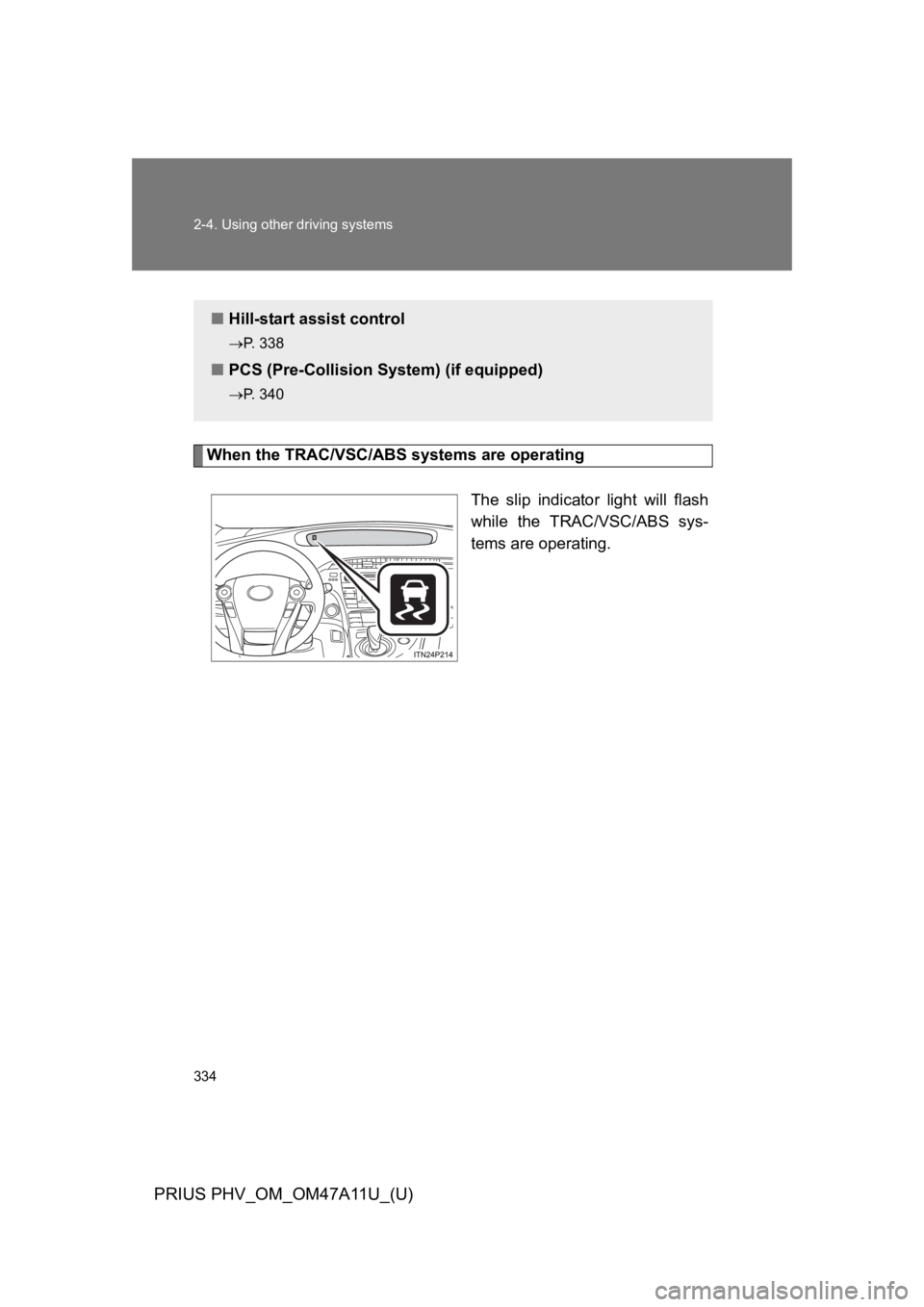
334
2-4. Using other driving systems
PRIUS PHV_OM_OM47A11U_(U)
When the TRAC/VSC/ABS systems are operating
The slip indicator light will flash
while the TRAC/VSC/ABS sys-
tems are operating.
■Hill-start assist control
�oP. 3 3 8
■PCS (Pre-Collision System) (if equipped)
�oP. 3 4 0
Page 377 of 728

335
2-4. Using other driving systems
PRIUS PHV_OM_OM47A11U_(U)
2
When driving
■Sounds and vibrations caused by the ABS, brake assist, VSC and
TRAC
●A sound may be heard from the engine compartment when the hybrid
system is started, just after the vehicle begins to move, if the brake pedal
is depressed forcefully or repeatedly, or 1-2 minutes after the hybrid sys-
tem is stopped. This sound does not indicate that a malfunction has
occurred in any of these systems.
●Any of the following conditions may occur when the above systems are
operating. None of these indicates that a malfunction has occurred.
•Vibrations may be felt through the vehicle body and steering.
•A motor sound may be heard after the vehicle comes to a stop.
•The brake pedal may pulsate slightly after the ABS is activated.
•The brake pedal may move down slightly after the ABS is activated.
■EPS operation sound
When the steering wheel is operated, a motor sound (whirring sound) may
be heard. This does not indicate a malfunction.
■Reduced effectiveness of the EPS system
The effectiveness of the EPS system is reduced to prevent the system from
overheating when there is frequent steering input over an extended period of
time. The steering wheel may feel heavy as a result. Should this occur,
refrain from excessive steering input or stop the vehicle and turn the hybrid
system off. The EPS system should return to normal within 10 minutes.
■Electric power steering system warning light (warning buzzer)
�oP. 5 4 4
Page 378 of 728
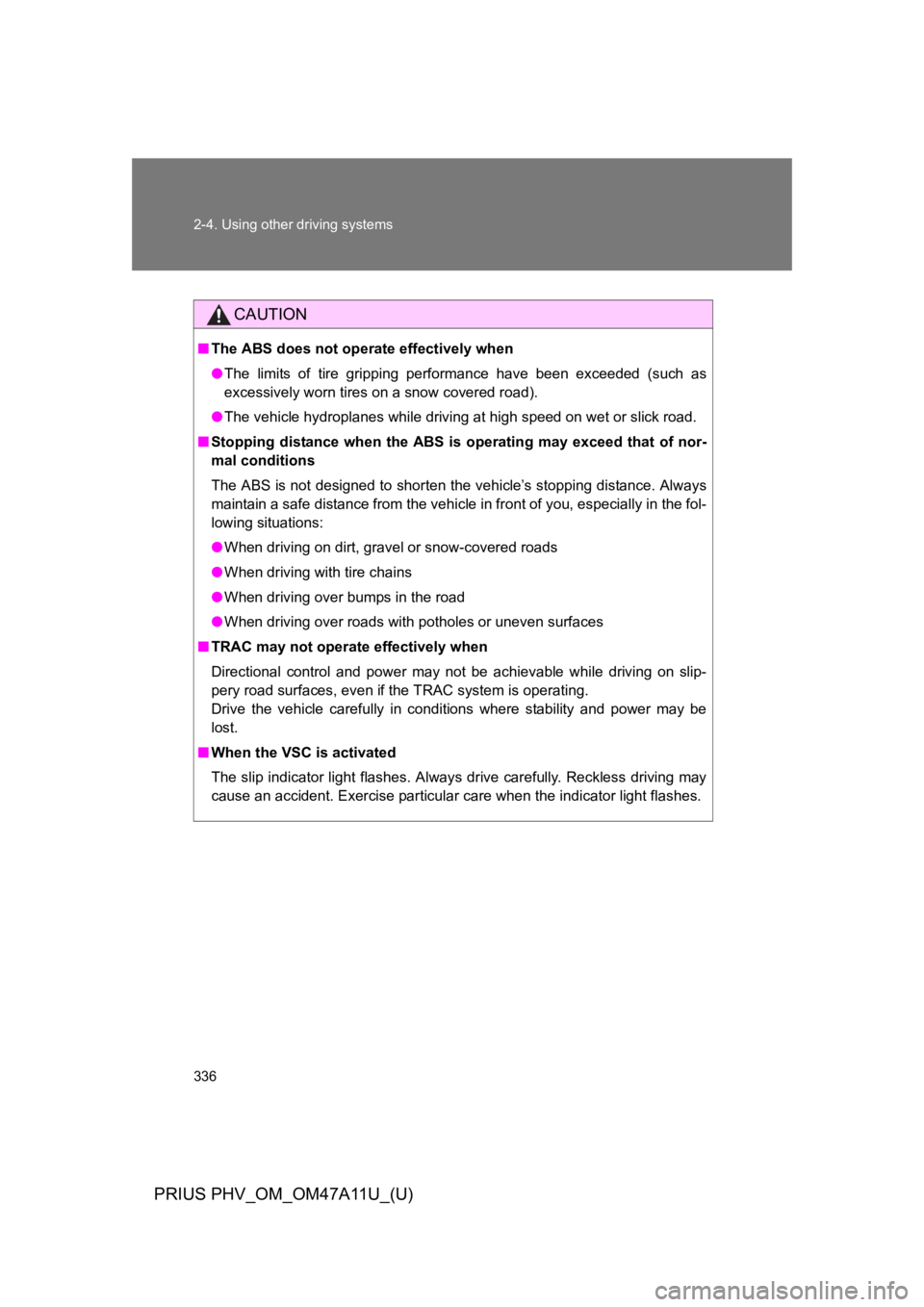
336
2-4. Using other driving systems
PRIUS PHV_OM_OM47A11U_(U)
CAUTION
■The ABS does not operate effectively when
●The limits of tire gripping performance have been exceeded (such as
excessively worn tires on a snow covered road).
●The vehicle hydroplanes while driving at high speed on wet or slick road.
■Stopping distance when the ABS is operating may exceed that of nor-
mal conditions
The ABS is not designed to shorten the vehicle’s stopping distance. Always
maintain a safe distance from the vehicle in front of you, especially in the fol-
lowing situations:
●When driving on dirt, gravel or snow-covered roads
●When driving with tire chains
●When driving over bumps in the road
●When driving over roads with potholes or uneven surfaces
■TRAC may not operate effectively when
Directional control and power may not be achievable while driving on slip-
pery road surfaces, even if the TRAC system is operating.
Drive the vehicle carefully in conditions where stability and power may be
lost.
■When the VSC is activated
The slip indicator light flashes. Always drive carefully. Reckless driving may
cause an accident. Exercise particular care when the indicator light flashes.
Page 379 of 728
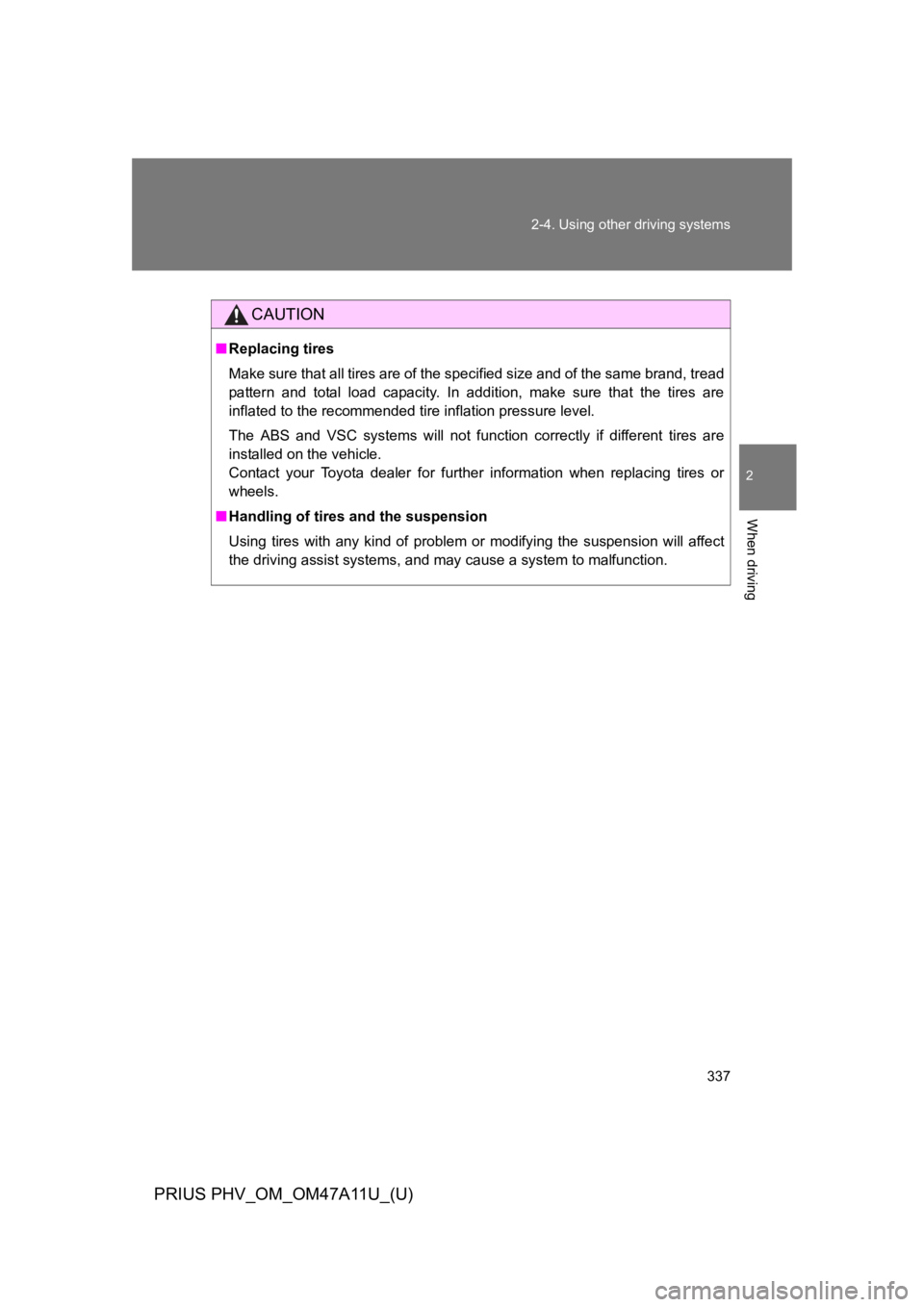
337
2-4. Using other driving systems
PRIUS PHV_OM_OM47A11U_(U)
2
When driving
CAUTION
■Replacing tires
Make sure that all tires are of the specified size and of the same brand, tread
pattern and total load capacity. In addition, make sure that the tires are
inflated to the recommended tire inflation pressure level.
The ABS and VSC systems will not function correctly if different tires are
installed on the vehicle.
Contact your Toyota dealer for further information when replacing tires or
wheels.
■Handling of tires and the suspension
Using tires with any kind of problem or modifying the suspension will affect
the driving assist systems, and may cause a system to malfunction.
Page 380 of 728
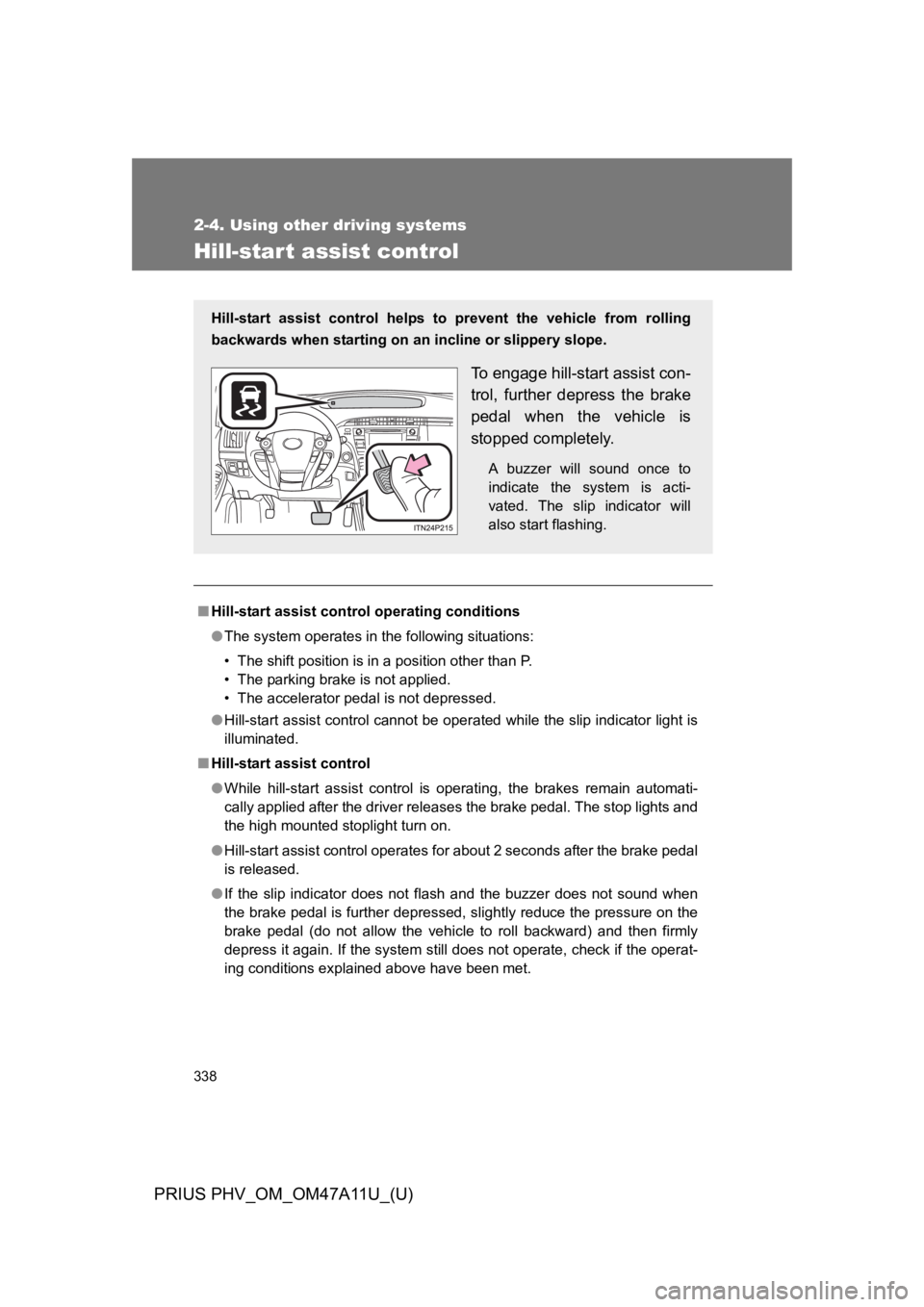
338
2-4. Using other driving systems
PRIUS PHV_OM_OM47A11U_(U)
Hill-start assist control
■Hill-start assist control operating conditions
●The system operates in the following situations:
•The shift position is in a position other than P.
•The parking brake is not applied.
•The accelerator pedal is not depressed.
●Hill-start assist control cannot be operated while the slip indicator light is
illuminated.
■Hill-start assist control
●While hill-start assist control is operating, the brakes remain automati-
cally applied after the driver releases the brake pedal. The stop lights and
the high mounted stoplight turn on.
●Hill-start assist control operates for about 2 seconds after the brake pedal
is released.
●If the slip indicator does not flash and the buzzer does not sound when
the brake pedal is further depressed, slightly reduce the pressure on the
brake pedal (do not allow the vehicle to roll backward) and then firmly
depress it again. If the system still does not operate, check if the operat-
ing conditions explained above have been met.
Hill-start assist control helps to prevent the vehicle from rolling
backwards when starting on an incline or slippery slope.
To e n g a g e h i l l - s t a r t a s s i s t c o n -
trol, further depress the brake
pedal when the vehicle is
stopped completely.
A buzzer will sound once to
indicate the system is acti-
vated. The slip indicator will
also start flashing.